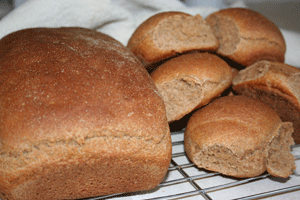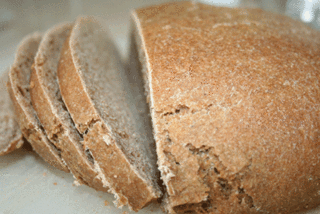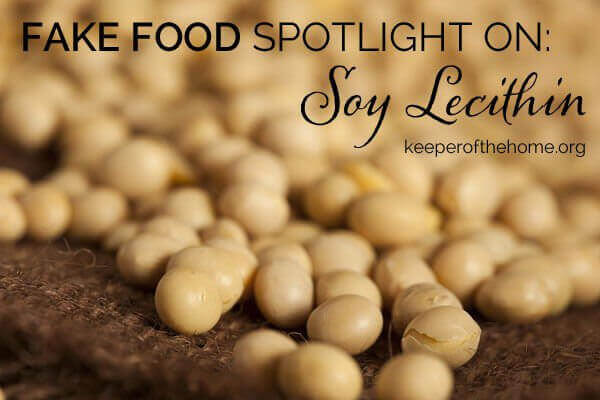Beautiful Bread Recipes
During the Q&A last week, I was asked if I had any more bread recipes that I wanted to share, and it was great timing, because I’ve just recently been quite happy with what I’ve been making (a very good thing, as I am somewhat baking-challenged).

Soaked, yeasted whole grain bread
The first recipe that I’ve been using and loving is a soaked and yeasted bread recipe, from Sue Gregg’s Baking with Whole Grains. I was pleased to see it on The Nourishing Gourmet last week, and doubly pleased to see that Kimi had discovered a link to where the recipe is posted on the web (thanks Kimi)!
Though this bread takes a bit of forethought and time, it does make two loaves (or else you can do one loaf and a pan of dinner rolls, etc.). My only complaint with this recipe is that I either have to have sprouted flour on hand (which I don’t always, and it takes several days to make more) or it is suggested to use unbleached flour (which doesn’t really exist when you use spelt or other alternative flours- whole grain is often the only option). The rising time with all of the flour (1/2 of the flour is soaked overnight, so that part is fine) is not sufficient to neutralize the phytates completely.
Nonetheless, this is a great recipe, certainly better than using a regular yeasted, non-soaked recipe, and if you do have sprouted flour, it’s fantastic! Lighter than some other whole grain breads I’ve made, so it’s nice for sandwiches.
Sourdough bread
This is what has me a bit more excited these days! I made my own starter, as I have before, but this time I am so much happier with it. I have previously made my starter using spelt, but this time used rye flour (as per Nourishing Traditions and Sue Gregg’s recommendations). What a difference! Wow!
The recipe that I’m using is Sue Gregg’s Sourdough Bread, though I’ve tweaked it slightly and have actually made it two different ways.
The recipe (from Sue Gregg’s whole grains book, which I love, love, love)
Sourdough Bread Recipe
Ingredients
The night before:
- 1 1/2 cups warm not hot filtered water
- 1 cup sourdough starter
- 4 cups spelt flour or whole wheat flour I use spelt, but I also substitute at least one cup with whole rye flour
Next day:
- 2 tsp salt
- 1/3 cup melted coconut oil or butter
- 2 tsp diatatic malt or 1/4 cup honey I don't add this
- Optional yeast 1/4 cup very warm water, 1 Tbsp active dry yeast, 1/2 tsp honey- mix and let sit for 5 minutes, then add with above ingredients to bowl
- 3-4 cups flour for kneading
Instructions
The morning before:
- Remove the sourdough starter from the fridge, let it sit for 12 hours (give it a stir, too).
The night before:
- Blend together (in non-metal bowl with non-metal spoon): filtered water, sourdough starter, 4 cups spelt flour or whole wheat flour.
- Cover with damp cloth and let stand overnight. (Make sure you replenish your sourdough starter with equal parts water and flour and let it sit out for a few hours before putting it back in the fridge).
Next day:
- Add to bowl and mix well: salt, melted coconut oil or butter, diatatic malt or honey, optional yeast.
- Add flour in the bowl until dough can be handled outside of the bowl, and need for about 20 minutes, until dough is smooth and resistant to kneading (when you knead it, it starts to bounce back at you a bit). Use around 3-4 cups flour for kneading.
- Place in lightly greased bowl (grease top of dough lightly), cover with damp cloth. Let rise in a warm place until double (can take around 3-4 hours, or even more).
- Punch down, turn dough over, cover and let it rise until doubled again (usually takes about half the time of the first rise).
- Punch down, knead briefly (a minute or two), let it rest 10-15 minutes. Shape into loaves, and put into greased pans. Let rise again until doubled (or almost doubled, about 20-30 minutes).
- Bake at 350 F for 35-45 minutes (I find closer to 35 minutes is usually enough, but I suppose it depends on your oven and baking pans).
- Place loaves on a racks to cool before slicing.
This recipe has worked really consistently for me the 3 times that I’ve done it, and my husband really loves it (and he’s a bit picky about which bread recipes he likes).

However, I still wasn’t loving that the second batch of flour added for kneading wasn’t getting quite long enough of a soaking/rising period (though it’s definitely better than in the yeasted bread recipe, in my opinion). Still not wanting to have to bother with sprouted flour, I decided to play around with the recipe a bit more.
I left out the yeast (which Sue says is optional, but you need to know that it will definitely change the recipe- more dense, doesn’t rise as high or nearly as fast). Instead, I added 6 cups of flour all at once, including the ingredients in 2 and 3 (except the yeast mixture, of course). I then immediately kneaded it for 20 minutes, and then left it as in Step 5, except I went to bed for the night.
The next day, probably late morning, it was around doubled in size, so I continued on with Step 6, etc. Each rise took longer than it would have with the yeast (the second rise took all afternoon, and the third rise took more than an hour). These long rising times are to be expected when making sourdough in the traditional way, though. The only catch is you need to make sure it has truly risen enough before you bake it, because it won’t rise that last little bit in the oven like a yeasted bread will.
This bread was also quite nice, and my husband definitely liked it better than my old sourdough recipe (though a bit less than the sourdough with yeast, as above). It didn’t rise quite as high as I would like it to, but I could give it more rising time and that should take care of that problem.
Hope that satisfies the bread makers out there for awhile! I have one more recipe that I intend to play around with, but I don’t have much extra baking time quite yet, so it might be a little while. I’d love to hear how you all make your sourdough bread, though, and what you use for your starter!






Thanks for the post! I look forward to trying these myself. To improve the texture of your whole grain breads, try adding a couple of tablespoons of vital gluten to the mix. You’ll be amazed at the texture!
My friend just lent me all of Sue Greggs books (o.k. so it was like 2 months ago!) but now that I’m finally feeling better and have more energy, I can get around to playing with them. I’ll have to try out those bread recipes first!
Thanks for the recipes!
I have been playing around with sourdough for a couple of weeks now, but without much success… My first batch was great, but it seemed like my starter fizzled out after that??? Anyways, I will have to give your recipe a try!
Jo Ann, I’ve thought so many times about trying to add gluten, but my main concern is that it comes from wheat, which my family is sensitive to. I don’t know if they would be sensitive to just the separated gluten portion or not, but that’s what keeps me from trying.
Does anyone with a wheat sensitivity know whether they still react using vital gluten flour?
Donielle, you’ve got to try them out- they’re awesome!
Jodean, make sure that you replenish your starter right away after you make bread, and that you leave it out for awhile before putting it in the fridge. It’s also really important to take it out that 12 hours before using it. As well, don’t let it stay too long in the fridge without taking it out to stir and let sit for at least a few hours, or to add a bit of fresh flour and water. Otherwise, the starter won’t have as much oomph to it, and over time could go bad or just stop working.
So with the second recipe, you don’t use honey OR diatatic malt? You just leave both options out?
I have found that if I want sort of an all purpose spelt (or wheat) flour like “white” flour then I sort of bang the whole grain flour through a seive. However, the seive HAS to be small enough holes, or else it won’t work. You’re left with some of the bran and germ in the flour but not as much. You stop banging on the seive when its mostly just bran and germ in there and the flour is in the bowl. I don’t often use all purpose type flour but its useful sometimes to know- like when I made cookies for a church function and they had to taste more what people are used to.
So can you use coconut oil in place of butter in anything? Which type of coconut oil do you recommend? There are so many out there with so many prices. I would think that like olive oil, virgin is better, and also not refined, and of course organic. Any other thoughts on that? I noticed the recipe called for this or butter. I can’t have dairy.
Hi there. When I followed the link for the Sue Gregg bread recipe, a lot of the measurements weren’t complete (i.e. a box is covering the amount you need of some of the ingredients). I’m sure this is to protect the recipe. Can someone tell me the measurements or would that be cheating? Thanks.
Nola, I didn’t add any sweetener because I’m using rye, and I wasn’t sure what the combination would be like. I’m sure it’s good if you’re using spelt or wheat. I’m not sure if I have a sieve small enough to do the flour sifting properly, but that’s a good way to do it, so thanks!
Yes, I do substitute coconut oil for butter in pretty much anything (unless there’s something I really don’t want that hint of coconut taste in). I buy virgin, organic, unrefined (this post has some more info on what to look for: http://www.thenourishinggourmet.com/2008/09/incorporating-coconut-oil-into-your.html).
My MIL and SIL and I are getting a 5 gallon tub from Mountain Rose Herbs (the link is on my sidebar). They also sell it in 1 gallon tubs. It’s the best price we’ve found so far. Are you sure you can’t have butter (despite the no-dairy)? My SIL has problems with most dairy, but still does fine with butter. Just curious. 🙂
thanks Stephanie for the recipes. I’m not much of a baker, but your breads look delicious enough that I just might try a recipe out one weekend. Wondering if you’ve ran across a good and easy wheat-free, egg-free, and dairy-free bread recipe? My son’s on a special elimination diet and I feel so bad, the poor kid is really missing his bread.
What beautiful pictures, Stephanie! What beautiful bread! It is so nice that her recipe is online, but I do agree that it isn’t the greatest that a portion of the flour isn’t soaked. I love sourdough though! I am so glad that you found a recipe that works well for you. It is somewhat similar to how I make mine. 🙂
I have tried Sue Gregg’s spelt bread on a few occasions in addition to my own recipe, but recently I can’t seem to get them to rise properly. It rises nicely and then in the final baking stage it sinks. Any thoughts? Curious also how strong a flavor the sourdough has? I am not a big fan of sourdough and that has caused my delay in making my own. I have honestly been ready to throw in the towel in making my own bread but maybe you know the secret that I don’t! 😉
Sara, I can see the measurements completely when I look at it, although I think the web page is a bit funny (it has a couple of overlapping lines when I view it). If you go to that page, though, and look at the very top, you will see a link to a pdf file. If you open that file, it’s the original copy and (at least on my computer) the recipe is completely clear and easy to read. Let me know if that still doesn’t work for you!
Marlene, the link to my previous sourdough bread (right under the title Sourdough Bread, the words “I have before”), is a bread that I made with spelt, and no eggs or dairy. It doesn’t rise as nicely as these recipes, but for a kid who can’t have anything else, I’m sure it would b ea welcome treat!
Lindsay, I’m definitely no expert bread baker (really, truly, I’m not!), but is it rising too high? Maybe your yeast is working too well and you need to cut it by a 1/2 tsp? Or shorten your rising times slightly? Anyone else have an idea?
As for the taste of the sourdough, if you make it the way that I’ve adapated it (without the yeast) the taste is somewhat strong. If you make it her original recipe (as I’ve posted it here, or in the grains book, which I think you have) then it’s not really that strong of a sourdough, in my opinion. I would give it a try!
Thanks for the info on coconut oil. I will have to try some real butter some time to see…but for now I am not sure I could sort out my reaction as I am having so many digestion symptoms from pregnancy. I’ll have to try it in the future. I wonder why some people react to one and not the other…
I’m reading Cure Tooth Decay and his section on grains is VERY interesting. Many ancient cultures sifted off the bran and germ, leaving only a little of it in the flour they used. All whole grains, and especially oats, seem to add to the chances of tooth decay. The ancient cultures sifted, soaked or boiled, and soured. Jeepers! They went to great lengths to make grains healthy. Can’t recommend this book highly enough. According to him, the unsoaked flour should be unbleached, organic white.
I had read in Nourishing Traditions that freshly milled whole grain wheat was not ideal for Sourdough bread. I have not tried to make sourdough with my wheat. If I have a mixture of hard and soft wheat, do you think I will be able to successfully make a sourdough loaf? I have also never been successful at making a loaf by sprouting my grains first. Do you think this recipe would help?